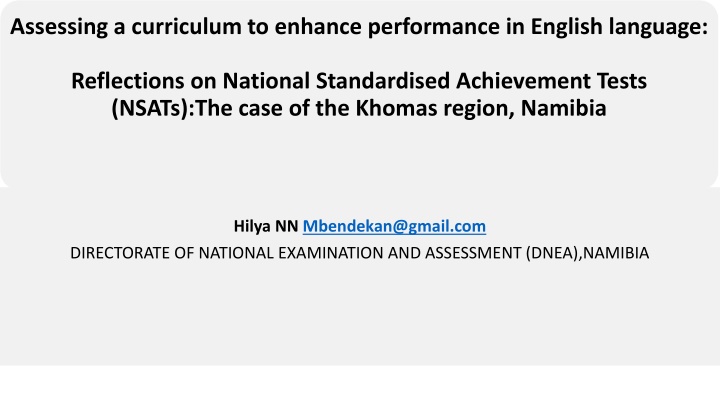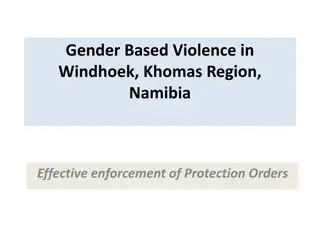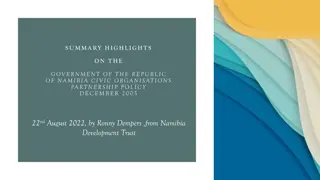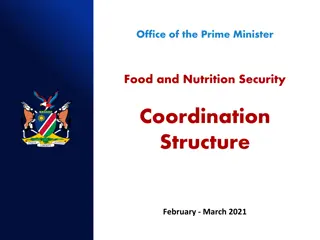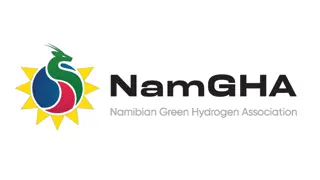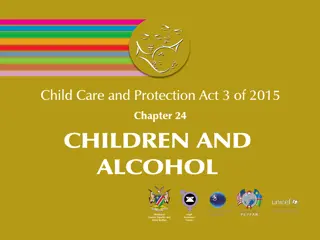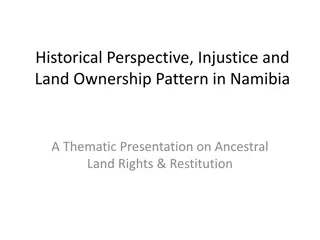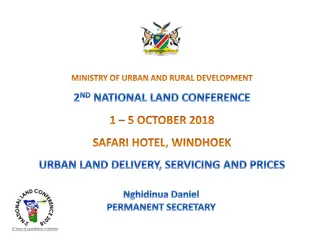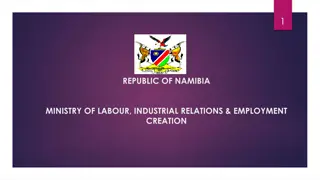Enhancing English Language Performance in Khomas Region, Namibia: Insights on National Standardised Achievement Tests
"Reflections on the implementation of Standardised Achievement Tests (SATs) in English language education in Namibia's Khomas region, focusing on teachers' perceptions and utilization of SATs reports to improve student performance. The study aims to address persistent challenges in English language achievement and provide valuable insights for educational stakeholders."
Download Presentation

Please find below an Image/Link to download the presentation.
The content on the website is provided AS IS for your information and personal use only. It may not be sold, licensed, or shared on other websites without obtaining consent from the author.If you encounter any issues during the download, it is possible that the publisher has removed the file from their server.
You are allowed to download the files provided on this website for personal or commercial use, subject to the condition that they are used lawfully. All files are the property of their respective owners.
The content on the website is provided AS IS for your information and personal use only. It may not be sold, licensed, or shared on other websites without obtaining consent from the author.
E N D
Presentation Transcript
Assessing a curriculum to enhance performance in English language: Reflections on National Standardised Achievement Tests (NSATs):The case of the Khomas region, Namibia Hilya NN Mbendekan@gmail.com DIRECTORATE OF NATIONAL EXAMINATION AND ASSESSMENT (DNEA),NAMIBIA
INTRODUCTION What are Standardised Achievement Tests? Forms of tests that require all test takers to take the same questions. Diagnostic assessment/tests. Scored in a standard or consistent manner, which makes it possible to compare the relative performance of individual students or groups of students, Nellie (2010). Appropriate indicators/tools to expose weaknesses and strengths of classroom instructions. Appropriate tools to adjust classroom instructions. Monitoring the overall learner performance of individual schools in specific basic competencies.
Standardised Achievement Tests (SATs) were firstly introduced in 2009, with the aim to focus on building a strong foundation in literacy and numeracy skills, (NDP5 2017/2018-2021-2022). This form of assessment was then designed to trace knowledge acquisition in the areas of literacy and numeracy skills in primary education. However: Persistent poor performance in levels of achievement in English subject has been observed in many schools across the country. Possible ideas: Misinterpretation of basic competencies in SATs report. Lack of interest among the teachers towards SATs report. Lack of understanding about the importance and the purpose of SATs. .
Purpose of study To determine the perceptions of English teachers about the importance of the SATs report in the teaching of English second language. To determine the degree at which the SATs report is used in daily lesson preparation for instructional remediation in English second language.
Research questions (a) Do English teachers find the SATs report helpful to assist them to address the shortcoming reflected in the report as per assessed basic competencies in the syllabus? (b) To what extent do English teachers interpret the SATs report to enhance performance in English as a second language?
Significance of the study The performance of learners in English has subject become one of the concerns towards the quality of education offered in the country. The results of this research will be a source of information on intended measures to address the challenge of English language in schools. The findings will also inform stakeholders such as educational managers and teachers in seeking more options to improve the performance of English subject, especially English Second Language across the curricula.
Literature review More literature on shortcomings and limitation of SATs. Numerical scores on a standardised test misleading indicators of student learning, since standardised tests can only evaluate a narrow range of achievement using inherently limited methods. However, Phelps(2005) argued that standardised tests reveal the weaknesses and strengths that corroborate or supplement a teacher s analysis. Taking an example of 2015 report, in English subject, 66% of the Grade 5 learners were classified under below basic and basic achievements categories compared to 86% in 2014 nationally, Mupupa (2016). In contrary, although this number is high (above 50%), however, the figure still shows a significant decrease of 20% in the learners falling in these two lowest performance level categories.
Methodology A combination of research methodologies. Desk analysis of schools reports available in the DNEA database. Qualitative methodology for interviews and open-ended questions conducted with school principals. Quantitative methodology, a set of questionnaires was administered to collect data from the English teachers at senior primary phase. 21 out of 47 schools were randomly selected for sampling purposes. SATs reports for the selected schools were also analysed. 42 teachers (for Grade 5 and 7),from the same selected primary schools, answered the questionnaires.
Data analysis Tables show a summary of SATs reports for a few schools from the sampled list. Baseline Follow up Change School A (2009) (2015) ( 2009 -2015) Urban- Private National 42 54 12 Region 62 67 5 School 92 94 2
School P2. (urban) Data analysis (continues) Baseline Follow up Change School B (2009) (2015) (2015-2009) Urban- Private National 42 54 12 Region 62 67 5 School 89 91 2
Data analysis (continues) Baseline Follow up Change School C (2009) (2015) (2015-2009) Urban- GRN National 42 54 12 Region 62 67 5 School 75 71 4
School G2. (urban) Data analysis (continues) Baseline Follow up Change School D (2009) (2015) (2015-2009) Rural - GRN National 42 54 12 Region 62 67 5 School 59 68 9
Data analysis (continues) Baseline Follow up Change School E (2009) (2015) (2015-2009) Rural- GRN National 42 54 12 Region 62 67 5 School 35 44 9
Data analysis (continues) Schools indicated above were selected from the sample of 47 schools in the Khomas region, to represent rural, urban, government and private schools. The figures indicated neither reflect nor represent the performance of all schools that participated in SATs, however, the comparison was made with a number of schools in each region. The year 2009 was the baseline while 2015 was a follow up. The gap between the two years in performance achievement for each school is not that big.
Table below shows the views of teachers towards the usefulness of the SATs report. Strongly agree Agree Strongly disagree Disagree SATs report is a true reflection of the learners performance as indicated by the 4 levels of achievement. 26 6 6 4 (62%) 6 (14%) 4 (14%) 17 (10%) 15 The report is more helpful in guiding us English teachers on how to assist learners to master the basic competencies in the syllabus. (14%) 28 (10%) 8 (40%) 2 (36%) 4 All English teachers at school are aware of the SATs report. (67%) (19%) (5%) (10%) The report is always shared and discussed at the departmental level. 3 21 12 5 (7%) 29 (50%) 8 (29%) 2 (5%) 3 The language/ terms used in the SATs report is/are easy to understand. (69%) 18 (19%) 16 (5%) 2 (7%) 5 The school principal assists us (English teachers) to understand the report at school level. (43%) (38%) 22 (5%) 1 (5%) 6 The Regional Office (Advisory Services) assists us to understand the report. 13 (31%) 8 (52%) 14 (2%) 12 (14%) 8 SATs report is always part of the discussion at English workshops at the circuit/ regional level. (19%) 7 (33%) 13 (29%) 9 (19%) 13 I use the SATs report during my English lessons regularly. (17%) (31%) (21%) (31%)
Data analysis (continues) 67% teachers agreed that they are aware of the SATs report, but surprisingly, only 17% indicated that they use the report for teaching. Although 62% indicated that the report reflects how much the learners mastered the basic competencies, it s still worrisome because the percentage of assistance from schools management is below 50%.
Discussion of the findings The study established that many English teacher at primary schools are aware of the SATs report. It s also impressive that some schools discuss and share the report with all other English teachers at school. However, the gap between how the report is useful as represented by 62%, and 14%, of how the report guides teachers how to assist the learners to master the basic competencies creates dubious impression. A lot has to be made to encourage teachers to incorporate comments stated in the report in their lessons regularly.
Conclusion The research concluded that many English teachers at primary school do not understand the SATs report. As a result, they do not use it to address the weakness in learners performance as indicated by the four levels of achievement of individual schools. It also came out that school principals do little to assist teachers to understand the importance of the report in terms of quality education.
Recommendations Recommendations made are: SATs reports should be availed, discussed and share by all English teachers at school. Principals and head of departments for Languages should play a major role to assist teachers to understand the report thoroughly. Advisory Services should take a lead to facilitate discussions on SATs reports during workshops or during school visits. It should be the responsibility of the Grade 4- 7 English teachers to understand the basic competencies in the syllabus in order to be able to help the learners to master those competencies, not only for SATs purposes, but for the learning of English language as a language of education in Namibia.
!!!!!!!!!!!!!!!!!!!!THE END!!!!!!!!!!!!!!!!!!!!! THANK YOU THANK YOU
